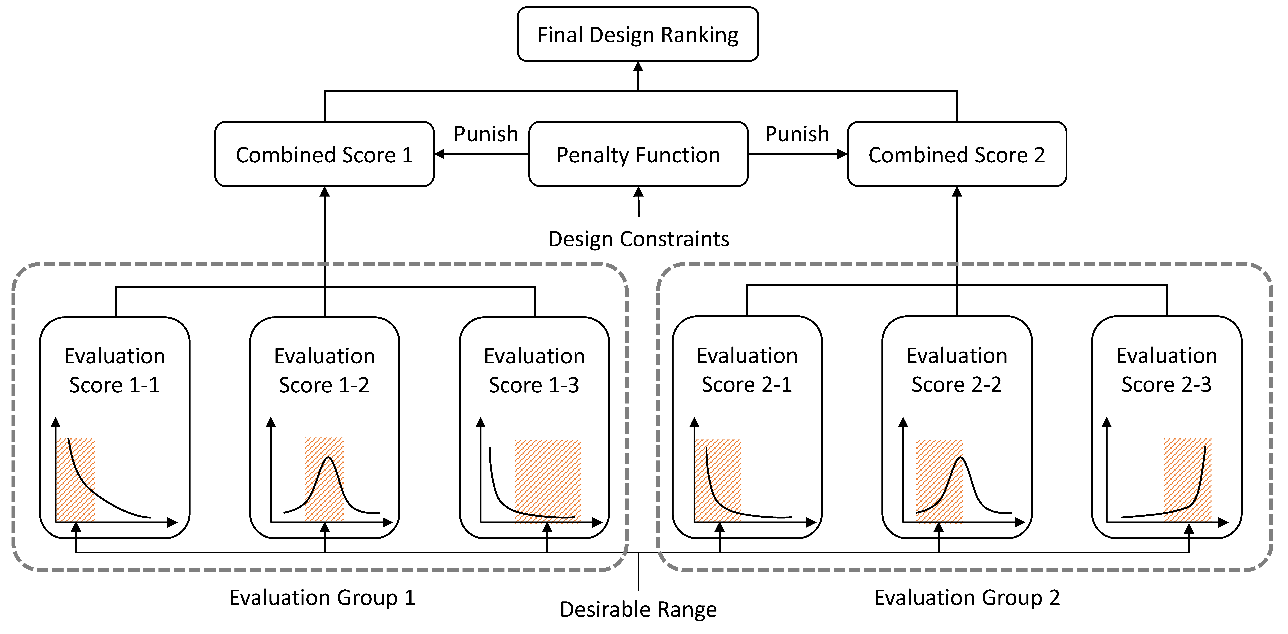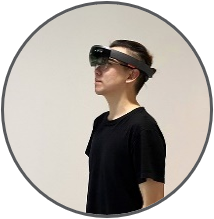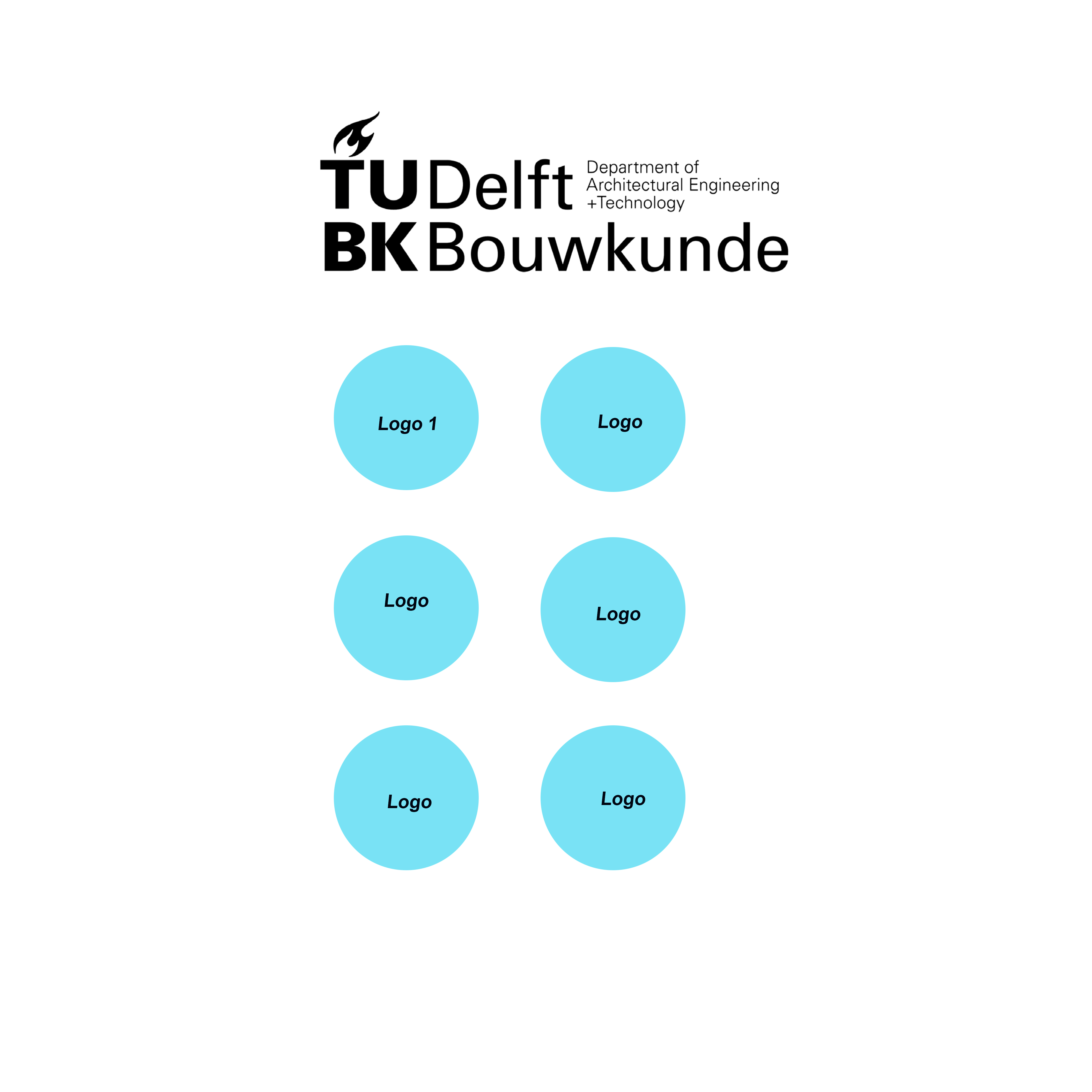| Session 1 . Algorithmic Design | |
| The Marching Shape 3D: Extensions of the Ice Ray Shape Grammar | |
| Alexandros Tsamis, Constantina Varsami | |
| Rensselaer Polytechnic Institute, USA | |
| In recent years, voxel-based approaches have been explored to address data distributions related to space and form in diverse design disciplines. While originally used for the digital reconstruction of the human body, they are now widely used in design to represent intensive spatial properties. However, a voxel-based design process can limit design outcomes due to a redetermined voxel size and space resolution. Although variable voxel density subdivision algebras exist, a generalized algebra for volume subdivision of any size and shape as well as computing between individual subdivided parts has not been implemented. This paper presents a generalized volumetric space dividing algebra for closed, convex Polyhedra of any shape, which extends the Ice-Ray Shape Grammar and demonstrates weighted 3D boundary subdivision. Specifically, we present an algebra for subdividing any closed convex polyhedron, we demonstrate a boundary-weight algebra that interrelates properties (weights) with a variably subdivided space and allows for their direct manipulation in space as the design process takes place. We also present rules for extracting isocurves and reconstructing iso-surfaces in a variably subdivided, weighted 3D space. Finally, a use case of The Marching Shape 3D is demonstrated in a renewable energy based design process. Algebras and schemas are shown for a general shape grammar as well as for a digital computing platform | |
| Between System and Improvisation: The Design Language of Donald Judd’s “100 untitled works in mill aluminum” | |
| Mahyar Hadighi, Mehrdad Hadighi | |
| Texas Tech University, USA; The Pennsylvania State University, USA | |
| In this paper, shape grammar is implemented as a computational design methodology to analyze the design language of Donald Judd’s “100 untitled works in mill aluminum”—permanently installed at the Chinati Foundation in Marfa, TX. Judd (1928-1994), an American artist, writer, and critic installed 100 aluminum objects—with the exact same outer dimensions (41”x51”x72”) but unique configuration, all made from ½” mill aluminum plates—over a four-year period from 1982 through 1986 in two former artillery sheds of a de-commissioned US military base. The question we are seeking to answer is whether these 100 works belong to a system, and, if so, what that system is and what delimits the system to produce 100 objects and no more. Our hypothesis, having spent considerable time examining the works and exploring the archival materials, is that there is a system, but the system is tempered by improvisational moments at multiple junctures in the project. We are interested in deciphering the system, but also the moments of artistic improvisation by Judd. The project is significant in relation to serial art works of the 50’s and 60’s. We have been calling them “serial” assuming there is a serial order and a system in their repetition and variation, but this very issue has not been researched in the context of the present work. | |
 |
|
 |
Mahyar Hadighi |
| Mahyar Hadighi is an Assistant Professor of Architecture and director of the graduate program in Historic Preservation at Texas Tech University. With a PhD specializing in shape grammars and the study of design language, his work concentrates on modernism understood in relation to historical and contemporary contexts. In addition to his PhD, he holds a post professional degree in historic preservation and a professional degree in architecture. | |
 |
Mehrdad Hadighi |
| Mehrdad Hadighi is a tenured Professor in the Department of Architecture at the Pennsylvania State University. He holds a PhD in comparative Literature, a post-professional graduate degree in architecture and a professional degree in architecture and a degree in studio arts. A licensed architect and founding principal of Studio for Architecture, his work focuses on drawing parallels between 20th century art, critical theory, and the constructive principles of architecture. | |
| Illustrating Algorithmic Design | |
| Renata Castelo-Branco, Antonio Leitao | |
| University of Lisbon, Portugal | |
| Architectural design is strongly based on visual and spatial reasoning, which is not easy to translate into algorithmic descriptions and, eventually, running programs, making it difficult for architects to use computational approaches, such as Algorithmic Design (AD). One of the most pressing problems is program comprehension. To overcome it, we propose an automatic illustration system for AD programs that produces annotated schemes of the program’s meaning. The illustration system focuses on a basic set of geometric elements used in most calculations to place geometry in space (points, distances, angles, vectors, etc.), and on the way they are manipulated to create more complex geometric entities. The proposed system automatically extracts the information from the AD program and the resulting illustrations can then be integrated into the AD program itself, intertwined with the instructions they intend to explain. This article presents the implementation of this solution using an AD tool to generate the illustrations and a computational notebook to intertwine the program and the illustrations. It discusses the choices made on the system’s implementation, the expected workflow for such a system, and potential future developments. | |
 |
|
 |
Renata Castelo-Branco |
| Renata Castelo-Branco is a master’s graduate in Architecture from Instituto Superior Técnico, Lisbon, Portugal. She is currently working as an early-stage researcher at the INESC-ID research and development institute in the context of her PhD in Computer Science and Engineering. Her research focuses on representation methods for algorithmic design, with the goal of facilitating programming-related tasks for the professionals of the building industry. | |
| Session 2 . AI-powered Architectural Ideation | |
| Architectural Sketch to 3D Model: An Experiment on Simple-Form Houses | |
| Hong-Bin Yang, Mikhael Johanes, Frederick Chando Kim, Mathias Bernhard, Jeffrey Huang | |
| École Polytechnique Fédérale de Lausanne, Switzerland | |
| Transforming sketches into digital 3D models has been an enduring practice in the design process since the first digital turn in architecture. However, 3D modeling is time-consuming, and 3D modeling software usually has a cumbersome interface. Aiming to bridge the gap between sketch and 3D model, we propose a framework that can turn a hand-drawn 2D sketch into a 3D mesh. The user can draw a sketch on the canvas through a web-based interface, and the corresponding 3D model will automatically be generated and shown aside. The 3D model can be downloaded or synchronized into the Rhino directly through Grasshopper. The proposed framework uses a machine learning-based approach to generate a 3D mesh from a single hand-drawn sketch by deforming a template shape. Since the generated models have an uneven surface, we apply an optimization step to refine the form, creating a more usable architectural 3D model with planar faces and sharper edges. We create the Simple House Dataset, which consists of 5000 single-volume houses, to train the neural network. We defined five categories of house typologies – distinguished by roof shape and other geometric properties – and generated 1000 models for each class with parameters chosen randomly. Each model includes a 3D mesh and 20 perspective line drawings from different angles. Although the limitation of the generalization ability makes it unlikely to replace the conventional 3D modeling software today, the fast sketch to 3D transformation allows architects to explore the possibility of various architectural forms and may speed up the design process in the early stage. The code of this project and the Simple House dataset has been published on Github | |
| Towards Human-AI Collaborative Architectural Concept Design via Semantic AI | |
| Shuyao Dai, Yang Li, Kazjon Grace, Anastasia Globa | |
| The University of Sydney, Australia; National University of Singapore, Singapore | |
| As artificial intelligence (AI) methods advance quickly, more and more researchers are becoming interested in how to incorporate them into architectural design. Co-creation between humans and machines is also gaining popularity, which lends credence to the idea that AI can aid in the creative phases of design. The research presented in this article develops an AI-assisted method for generative design. It envisions a pipeline that iteratively kneads from semantics to two-dimensional (2D) images to three-dimensional (3D) models and back again by combining a semantic AI model (CLIP) with differentiable rendering. It also enables conceptual form exploration in Rhino3D with the help of a neural network built on a Text2Mesh tool. The real-time, conceptual, iterative interplay between human designers and AI collaborators could be facilitated by this pipeline. We also conducted a case study on early concept exploration for a museum to validate our approach, showcasing its potential in practical design scenarios | |
| Use of Language to Generate Architectural Scenery with AI-Powered Tools | |
| Hanım Gülsüm Karahan, Begüm Aktaş, Cemal Koray Bingöl | |
| Istanbul Technical University, Turkey; Altınbaş University, Turkey; Delft University of Technology, Netherlands | |
| The quality of communication with a computer impacts how the designer performs during the design process. Today, Artificial Intelligence (AI) empowers the designer by expanding the solution space using the expertise from previous knowledge. However, the developments in AI-powered design tools mainly focus on visual and spatial enhancements. In the last decade, AI-powered design tools mostly experimented with image transformation models (GANs) to provide fast insights to designers using learned experiences, simulations, or datasets. The studies on the design process using verbal language with the help of AI are limited. Therefore, designers’ capacity to communicate with intelligent machines would lead us to envision the future of AI-powered design tools. In design practice, designers develop individual and contextual studies through digital tools. This study investigates the process of architectural visual generation and verbal communication to describe architectural images by architecture graduates with prior experience or no experience in prior with Midjourney. The research focuses on the designers’ semantic language during the design process with the AI-powered tool and analysis of the verbal part of the communication. The results of this study show that participants' first impressions of the image and how they express their impressions through description do not correspond with how Midjourney interprets those descriptions. Furthermore, architects’ image generation process using the tool is nonlinear. As architects develop a deeper understanding of changing modes of interactions, they are more likely to benefit from AI-powered tools as collaborative entities | |
 |
|
 |
Hanım Gülsüm Karahan |
| Hanım Gülsüm Karahan is an architect and a computational designer doing her master's degree in the “Architectural Design Computing” program at Istanbul Technical University. Her research area focuses on machine learning in architectural design. Currently, investigating stochastic approaches which generative deep learning models capitalize on during the design process to provide architects with more informed design space. | |
| The House that Looked like it Should Collapse. Natural Language Processing for Architectural Design | |
| Nadja Gaudillière-Jami | |
| Technical University Darmstadt, Germany | |
| Machine learning (ML) has not only become increasingly popular in the fields of computer science and AI since the 1990s, it also has become increasingly used in architectural design in the past few years. While some experimentations deal with fabrication or engineering issues and performance prediction, others deal with layout generation. As in any process involving ML, layout generation necessitates a large database to train the system. These databases are currently in their majority 2D images or 3D-models. However, these databases are often either scarce or monolithic - they gather too few examples and / or examples that are very similar in regard to the vast diversity of architectural design. The Generative Pre-trained Transformer 3 (GPT-3) is a language model developed by Open AI to produce text answers to text prompts submitted to it. With 175 billion parameters, it is one of the largest models available. It has been trained on billions of online texts, coming from databases such as Common Crawl, Books2 or Wikipedia. The texts it generates are therefore based on a very large range of information, including about architecture. While only being word-based, the amount of information it has been trained with makes the suggestions relative to architecture GPT-3 outputs worthwhile to examine. What patterns relating to architectural design emerge when training a ML algorithm on such a database, much larger than what our field is currently used to manipulating? We have been testing and calibrating GPT-3 in order to obtain descriptions of buildings that could then be translated into drawings, i.e design briefs. This calibration has also enabled us to assess the patterns identified by the system. We thus propose an evaluation of how design issues usually perceived by architects as key are handled by GPT-3 - location, climate, program, references, inhabitants and their peculiarities. This evaluation is based on an assessment method that can be applied to other general ML tools in architecture, including image generators. Upon performing these tests, some prompts generated particularly various and interesting answers, oscillating between rationality and fiction. The present paper uses these prompts as examples in order to deepen the assessment of GPT-3, to evaluate its potential as a design tool and to open a larger discussion about databases within ML use for architectural design. | |
 |
|
| Architectural and Social ‘Word Forms’ Slippage with Deep Learning | |
| Immanuel Koh | |
| Singapore University of Technology and Design, Singapore | |
| The paper aims at contributing to the exploration of co-creative design processes afforded by the ‘slippery’ interplay of ‘word forms’ as found in human participatory designs and AI deep generative modelling. Conceptualised as an AI-augmented form-ideating social platform, it leverages the unique, and often implicit, relationship between the architect’s use of textual description and visual representation of three-dimensional building forms, regardless of its site, program, and budget specificities. The paper draws from similar features found in existing platforms such as those for image sharing (Pinterest), image searching (Google Images), image breeding (Artbreeder), and text-based image generation (DALL·E 2, Stable Diffusion or Midjourney). However, unlike the large-scale pre-trained deep learning models and generic image databases provided by these platforms, the implicit disciplinary graphic and written languages of architects used in communicating forms suggests a need to not only facilitate the users in finding forms, but also the option to create their own datasets of ‘named’ forms and to then train their own AI models accordingly. Towards this end, the siteless, scaleless, grayscale, isometric, captioned (2-word phrases) thumbnail freehand sketches of three-dimensional building forms are adopted in this study as an architecturally representative and convenient training dataset. The paper will present the methods: extracting captioned sketches (OCR), training different deep generative models (GANs), vectorising captions (GloVe) and sketches (ResNet-18), and performing semantic clustering on captions and sketches (K-Means & PCA); followed by the results which illustrate the platform’s key functionalities: inferring captions of input sketch (Form2Word), searching sketches with input captions (Word2Form), and searching or creating similar sketches with input sketch (Form2Forms). The paper thus contributes to an alternative co-design framework for architectural form ideation by reconfiguring the creative affordance between texts and images with the deep learning models | |
 |
|
  |
Immanuel Koh |
| Immanuel Koh holds a joint assistant professorship in Architecture & Sustainable Design (ASD) and Design & Artificial Intelligence (DAI) at the Singapore University of Technology & Design (SUTD). Trained at the Architectural Association (AA) and Zaha Hadid Architects, he holds a PhD from the School of Computer Sciences and Institute of Architecture at EPFL in Switzerland. Immanuel is the author of the book Artificial & Architectural Intelligence in Design (2020). | |
| Session 3 . Performance-based Design | |
 |
|
| Enabling Flexible Architectural Design Re-representations Using a Phenotype-based Strategy | |
| Ling Ban Liang, Bige Tunçer | |
| Singapore University of Technology and Design, Singapore | |
| Architectural design is driven by qualitative variables like spatial aesthetics and geometry appreciation. At the early explorative stage, flexible re-representation of information is used to discover design solutions. However, in computational design, current data management methods are constrained by genotype and performance representations. These strategies do not enable a similar level of flexibility. As such, this paper presents a phenotype-based strategy that allows design logic to be transferred between computational design processes. Across different design spaces, similar phenotypes can be bridged based on their appearance. This will be demonstrated using room footprints and daylight distribution results which are represented using Elliptical Fourier descriptors and Gabor filters. This enables flexible re-representations as the algorithm can now appreciate geometrical properties. Examples to demonstrate design logic transfer, which are guided by the phenotype space, will be covered in two different scenarios: 1) in a search scenario — where the search direction of an unexplored design space is influenced by learnings from an explored design space, and 2) in a scenario where all design spaces are explored — the data structure and possibilities afforded to new search scenarios. | |
 |
|
 |
Bige Tunçer |
| Bige Tunçer leads the Informed Design Lab, which focuses on data collection, information and knowledge modeling and visualization, for informed architectural and urban design. She has led and participated in research projects on design computation. She currently leads a large multi-disciplinary project, investigating multi-modal data collection on user and usage information of public spaces in residential new towns, and develops a design system for the adaptive redesign of such spaces. | |
 |
|
| Expanding Performance-driven Parametric Design Spaces Through Data Streams | |
| Laura Hinkle, Nathan Brown | |
| The Pennsylvania State University, USA | |
| There has been recent interest in using sampled datasets of parametric models to create fast, accurate predictions of building performance. This rapid feedback can enhance creative processes in which a designer is exploring potential design options live, compared to waiting for the results of individual simulations for each design possibility. However, basing these predictions on an existing parametric dataset can be limiting, as the original variable structure must be maintained. Drawing from advances in data streams, this paper proposes and evaluates strategies for adding a variable to the parametric design space without needing to re-simulate the entire dataset to update the prediction. Several approaches are tested to expand the design variables for three situations: a daylit room, a massing model for energy prediction, and a stadium geometry. The main strategy, an online updating method, significantly reduces the number of new simulations required with the new variable to achieve reasonably accurate performance prediction, compared to re-simulating the entire dataset with the new variable included. However, in certain cases this approach only slightly outperforms creating a simple linear model with just the new datapoints. Future work can continue to investigate how to best enable the addition of variables to a parametric design space and corresponding performance prediction model. | |
 |
|
 |
Laura Hinkle |
| Laura Hinkle is a PhD candidate in the Architectural Engineering department at Penn State University. She holds a Bachelor and Master of Architectural Engineering from Penn State University. Laura interned at the Pacific Northwest National Laboratory on the Data-Driven Design team. Her research interests include building envelopes and applications of data science to building design. | |
| A Design Ranking Method for Many-Objective Evolutionary Optimization | |
| Likai Wang, Do Phuong Bui Tung, Patrick Janssen | |
| Xi’an Jiaotong-Liverpool University, China | |
| This study presents a design ranking method for evolutionary optimization that is aimed to address design optimization problems with many performance-related evaluation metrics. The application of the method consists of three strategies. First, all evaluation scores are expressed as percentages that indicate the proportion of the design achieving acceptable performance. Second, related evaluation scores are grouped, and for each group, a combined score is calculated using a weighted product approach. Third, design populations are evolved using the Pareto optimization of the combined evaluation scores. The combination of the three steps helps designers to define and organize the design evaluation metrics and can also produce optimization results revealing meaningful information. A case study is presented to demonstrate the efficacy of the proposed design ranking method. The relevance of the proposed method to performance-based evolutionary optimization research is also discussed. | |
 |
|
 |
Likai Wang |
| Likai Wang is currently an assistant professor at Xi’an Jiaotong – Liverpool University in China. His research interests include parametric design generation, evolutionary optimization, and computational design thinking in architectural design and urban design. He is also the developer of EvoMass, a Grasshopper plugin for performance-based building massing design generation and optimization. The presented study was part of a project he was involved in as a postdoctoral fellow at the National University of Singapore. | |
| Optimization Strategies of Architecture and Engineering Graduate Students: Responding to Data During Design | |
| Stephanie Bunt, Catherine Berdanier, Nathan Brown | |
| The Pennsylvania State University, USA | |
| Both architects and engineers increasingly use design optimization in the early stages, but it is unclear how designers’ disciplinary background may influence their optimization strategies. In considering designs with multiple conflicting objectives, large datasets of options are often produced, which can be difficult to navigate. Architects and engineers may engage with optimization tools and their feedback differently based on their background, which can affect collaborative efforts and influence design outcomes. In this study, graduate architecture and engineering students with experience in optimization responded to a design task with both quantitative and qualitative goals. The task required participants to establish and explore their own parametric design variables, producing large datasets with numerical and visual feedback. Screen recordings of the design sessions were analyzed to characterize optimization events initiated by the designers, revealing when and how often they ran optimization routines and how they reviewed the optimization feedback. The study showed that the architecture students tended to use optimization later and iterate less than the engineering students, who relied on quantitative data more often to edit their design space and justify their decisions. Future efforts to incorporate design optimization into graduate education should be cognizant of these differences, especially in multi-disciplinary settings that encourage architects and engineers to mutually engage with data during collaborative design. | |
 |
|
 |
Stephanie Bunt |
| Stephanie Bunt is a PhD candidate in Architectural Engineering at the Pennsylvania State University. Her research focuses on characterizing the design strategies of architects and engineers, particularly when navigating design space exploration tools. She has a robust background in both disciplines and has taught structural courses and design studios. In continuing her dual approach to architecture and engineering, she aims to introduce creative approaches to building design education. | |
| Wieringa Surface: The Implementation of Aperiodicity into Architectural Acoustics | |
| Ross Cocks, John Nguyen, Brady Peters | |
| University of Toronto, Canada | |
| At the intersection of order and disorder exists a balance that is referred to as aperiodicity. This mathematical concept is exemplified by the famous Penrose tiling methods, which display local five-fold symmetries that quickly dissipate globally. Architectural designers have previously exploited this property through floors tiling’s, sculptures, and building facades. However, like mathematicians in the latter half of the 20th century such as Nicolaas Govert de Bruijn and R.M.A. Wieringa, designers in the early 21st century are now looking to the third dimension. In acoustics, surfaces with complex sectional profiles have been demonstrated to have scattering properties where the relationship between depth and width of undulations relate to the amount and frequency of the sound scattered. Mathematical sequences have been demonstrated to have optimal sound scattering properties, however, these mathematical sequences are periodic, and can therefore create unwanted acoustic effects. This research proposes combining the concept of aperiodicity with the predictability of a mathematical formula and defined through a parametric model, where the acoustic performance of these aperiodic surfaces will be analyzed through simulations. The contributions of this research are two-fold: first, we have developed a novel approach to creating a 3D object using parametric modeling to generate a Wieringa Surface, which when orthographically projected to 2D creates a Penrose Tiling; and second, we have carried out preliminary simulations that suggests there is a potential for this complex mathematical surface to exhibit sound scattering properties without periodic effects. This paper documents the parametrization of a specific case of the “Cut and Project Method”, a mathematical method by which a slice of a multi-dimensional periodic space is selected through a cutting window and then projected to a lower dimension to produce aperiodic forms. | |
| Session 4 . Urban Models and Analysis | |
| Cost-Effective 3D Urban Massing Reconstruction of Public Aerial LiDAR Scans | |
| Jinmo Rhee, Brad Williams | |
| Carnegie Mellon University, USA | |
| While highly developed metropolitans such as Los Angeles and New York City facilitate the availability of high-definition and costly digital urban models for designers and planners, second-tier American cities lack similar resources for digital design environments. This unbalanced availability of digital urban contexts discourages the utilization of 3D models for urban research planning in less developed cities. In an attempt to make digital urban models more widely available, this paper introduces an approach on publicly accessible aerial LiDAR scans to automate inexpensive 3D reconstructions of existing building mass at the urban scale. The automation includes collecting raw data from an aerial LiDAR scan database and processes their point clouds for architectural representation. With the understanding that a building is represented as a composite of roof planes, building forms are identified and created via a point cloud plane detection and geometrical approximation. Implementing the automation in the widely used design software, we suggest an automation framework of a cost-effective method for building massing in urban scale. By applying the automation framework to five different urban scenarios, we can evaluate the quality of the reconstruction of building masses and limitations. The reconstructions are quite swiftly executed with reasonable accuracy in urban scale. | |
| Fine-Grained Long-Term Analysis of Resurgent Urban Morphotypes | |
| João Paulouro, José Nuno Beirão | |
| University of Lisbon, Portugal | |
| We present the methodology employed for the study of an architectural type within the Lisbon Metropolitan Area spanning over eight hundred years with two chief epochs of exponential growth and commonly referred today as the gated community. Covering the use of remote sensing, georeferencing, data scraping, contemporary census, early modern period population counts, spatial disaggregation, spatial analytics, network analysis and new network-based socio-urban measures, the methodology offers a single semi-automated design for the reproducible urban analysis of a metropolitan area, culminating with the production of eight urban models covering periods from the late XVI to the early XXI centuries. Evaluation carried out on the models through statistical analysis and probabilistic unsupervised learning methods shows the resurgence of morphological and socio-urban patterns separated in time by centuries of urban development. | |
| Street Voids: Analyzing Street-level Walkability Based on 3D Morphology and Remotely Accessible Urban Data | |
| Elif Ensari, José Beirão, Mine Özkar | |
| New York University, USA; University of Lisbon, Portugal; Istanbul Technical University, Turkey | |
| Urban planning and design approaches that aim to leverage walking as a sustainable means of transportation require a thorough understanding of the built environment. Information regarding density, diversity, accessibility, and attractiveness of streets is critical to assess walkability, yet it is also resource-intensive to acquire through traditional methods. We present a computational analysis method that captures and aggregates information on walkability indicators encapsulated in the 3d morphology, street-view imagery, and POI data of streets, using a 3d component called the Street Void. This component builds on the Convex and Solid-Void models which are 3d representations of open-urban spaces informed by the interrelationships between topography, surrounding buildings and other immediate physical boundaries, and facilitates the quantitative evaluation of walkability attributes. The method is unique in that it allows for the walkability evaluation of urban open spaces in the micro level, with a semi-automated algorithm and utilizing remotely accessible urban data. We present the implementation of this analysis on four neighborhoods of Istanbul and Lisbon, demonstrating insight drawn from its quantitative output. The research interconnects knowledge in the domains of computational design, behavioral psychology, urban management, and planning; with the contribution of a novel quantitative analysis of streets to inform urban decision-making processes. | |
 |
|
 |
Elif Ensari |
| Elif is a Research Scholar in the Transportation and Land-Use Program at New York University’s Marron Institute. She was trained as an architect specializing in architectural design computing. She holds a master’s degree from Southern California Institute of Architecture and a dual Ph.D. degree from Istanbul Technical University and University of Lisbon. Her research utilizes urban analytics to support planning, policy making and design with a focus on sustainable mobility. | |
| Visualizing Invisible Environmental Data in VR: Development and Implementation of Design Concepts for Communicating Urban Air Quality in a Virtual City Model | |
| Clara Larsson, Beata Stahre Wästberg, Daniel Sjölie, Thommy Eriksson, Håkan Pleije | |
| University West, Chalmers University of Technology, University of Gothenburg, Sweden | |
| As cities continue to grow, the desire to combine densification with sustainability and greenery may present a challenge to air quality, resulting from reduced ventilation caused by dense buildings and vegetation. To support the careful urban planning required, effective and interactive tools that can visualize and communicate information about air quality to stakeholders are essential. In a transdisciplinary research project aiming to explore such visualizations a prototype pedagogical virtual reality tool was developed, allowing users to explore the impact of aspects of the built environment upon urban air quality. The tool was evaluated with adolescents in upper secondary school through interviews and observations, as well as with the general public through a questionnaire study. This paper provides insights, potential solutions, and initial assessments relevant to data visualization in 3D and immersive analytics in urban planning and stakeholder communication. Identified challenges include difficulties with color association and data distinguishability, and as well as tool complexity relating to the many features requested by experts involved in a transdisciplinary project | |
 |
|
 |
Clara Larsson |
| Clara Larsson is a university lecturer and researcher in Informatics at University West in Sweden. Her research focuses on digital visualization techniques and design of virtual environments with a particular interest for studying the implications of perception and aesthetics of data visualization. Clara’s research ambitions are thus to enhance the design, visualization, and intelligibility of virtual environments that visualize abstract datasets and concepts. | |
| Session 5 . Urban Design | |
| Transforming Large-Scale Participation Data through Topic Modelling in Urban Design Processes | |
| Cem Ataman, Bige Tunçer, Simon Perrault | |
| Singapore University of Technology and Design, Singapore | |
| The advancements in digital tools and data collection methods ensure the continuing growth of textual data obtained through large-scale participation processes in urban contexts. In order to extract the thematic content of such underutilized textual datasets, topic modeling (TM) and content analysis have been deployed as promising AI-based Natural Language Processing (NLP) techniques. Yet, implementing such techniques has not been exploited in urban design domains due to the complexity of textual datasets and the lack of a systematic evaluation framework. In this paper, we addressed the challenges in the utilization of large textual data by using a real-world dataset collected via a digital participation platform in Madrid, Spain. Firstly, we identified prominent data structures and potential information embedded into the dataset by using a document-oriented NoSQL database. In this step, we systematically discussed data pre-processing steps to convert them into a series of structured data collections. Secondly, we evaluated three different TM algorithms, i.e. LDA, LSI, and HDP, according to a number of hyperparameters controlling the learning process. This step aimed to reveal the required number of topics to extract meaningful content through the algorithms. Lastly, we presented possible textual data visualization techniques to enable the use of textual information in digital participation processes. Consequently, this paper facilitates the use of large textual datasets by investigating data structures & processing, revealing the potentials of different TM algorithms, and eventually analyzing the results with the support of urban big data analytics and computational linguistic techniques for informed urban design processes | |
 |
|
 |
Cem Ataman |
| Cem Ataman is an architect and a Ph.D. candidate in Architecture and Sustainable Design (ASD) at the Singapore University of Technology and Design (SUTD). His research primarily centers around sustainable cities, digital participation, and collaborative design methods within urban transformation contexts. He works closely with municipalities in Europe and Asia, assisting them in utilizing AI to analyze their big urban datasets for well-informed urban design solutions. | |
| AI-assisted Exploration of the Spirit of Place in Chinese Gardens from the Perspective of Spatial Sequences | |
| Zihao Wang, Xiaofei Zhang | |
| Ecole Nationale Supérieure d’Architecture Paris-Malaquais, France | |
| The Chinese garden style is not only a decorative aesthetic but also a composition of spaces. Chinese gardening is about creating narrative spatial sequences, and the composition of the views in each space is also important. We propose to simulate these approaches with AI. Firstly, we used the pix2pix algorithm to generate a plan layout and determine the paths that connect the spatial sequences. secondly, we will enter the first-person view. Whereas traditional architects design by plans and axonometric drawings, our work focuses on the ‘spirit of place’. We used Isovist to simulate the spatial elements that one sees as he or she moves through space over time and encoded these spatial elements, then we chose RNN (LSTM) to learn this spatial sequence composition of the ‘spirit of place’, and to generate a practical project with the ‘spirit of place’ in Chinese gardens. The RNN (LSTM) model can handle the information of the sequence well, that is, the input before and the input after are related, and in a spatial sequence, the spatial nodes before and the spatial nodes after will also jointly form a sense of spatial rhythm. Finally we tried to materialize the model with CycleGAN to refine the workflow of the auxiliary architectural design. We tested this methodology in a renovation program for a Chinese village to observe the ‘spirit of place’ created by AI(Artificial Intelligence). This approach could potentially be applied to other user experience-oriented aided designs. Our objective is to establish a workflow that enables architects to collaborate better with AI. | |
 |
|
| Zihao Wang and Xiaofei Zhang | |
| Zihao Wang is a graduate of ENSA Paris-Malaquais. I have previously worked at Ateliers Jean Nouvel, and I am currently working at TLR Architecture in France, focusing primarily on healthcare architecture. In addition, I have conducted some research on parametric architecture and artificial intelligence in architecture. Xiaofei Zhang graduated from ENSA Paris-Malaquais. Currently working as an architect at Sempervirens agency in Paris. Interested in data-driven design, counterculture, algorithm music, new architectural paradigm in AI age. | |
| A Parametric Tool for Outdoor Shade Design: Harnessing Quantitative Indices and Visual Feedback for Effective and Efficient Climatic Design of Streets | |
| Or Aleksandrowicz, Ezra Ozery | |
| Israel Institute of Technology, Israel | |
| To date, there is a lack of orderly and data-based methods for quantifying, evaluating, and benchmarking street-level outdoor shade in streets and urban public spaces. The lack of such methods impedes the effective design of walkable and liveable outdoors in locations where shading is essential for significantly mitigating outdoor heat stress. To address this shortcoming, we have developed Kikayon, a relatively simple parametric tool that allows planners and designers to easily compare the effect of design alternatives on outdoor shade provision based on building geometry and tree canopy morphologies while taking into account the variance of exposure to solar radiation at different times. The tool calculates several shade and tree indices, some we have originally developed, for each street design, giving users quick and straightforward feedback and enabling them to quantitatively compare design alternatives. Our tool is implemented as a Grasshopper code that harnesses several components of the Ladybug Tools suite. | |
 |
|
 |
Dr. Or Aleksandrowicz |
| Dr. Or Aleksandrowicz is an Assistant Professor in the Technion’s Faculty of Architecture and Town Planning and the head of the Faculty’s Big Data in Architectural Research Lab. He is a trained architect who has conducted research in diverse fields, including urban and building climatology and the historical evolution of building technologies. Part of his current research work focuses on the development of systems and tools for outdoor shade quantification. | |
| Urban Shaderade. Building Space Analysis Method for Energy and Sunlight Consideration in Urban Environments | |
| Francesco De Luca, Abel Sepúlveda | |
| Tallinn University of Technology, Estonia Karlsruhe Institute of Technology, Germany |
|
| The built environment contributes significantly to climate change being responsible of a large portion of global energy use and CO2 emissions. In the scientific community it become evident that designing urban environments and buildings which do less harm or have a neutral impact on the environment is not enough anymore to realize sustainable cities. This paper presents a method to help design buildings with a positive impact on the context, filling vacant lots in dense urban environments. The method defines optimal building boundaries to reduce energy use of existing surrounding premises, while guaranteeing them adequate solar access. A two-step computational workflow was developed. In the first step building space positive, negative and neutral effect on cooling, heating and electric lighting energy use is analyzed in consideration of shading factors and beam solar energy. In the second, the effect of the positive and neutral building space on sunlight exposure of neighboring premises is considered, generating energy and sunlight optimized conceptual building massing. Initial results of the method application in several urban conditions, different building use and scenarios and in different cities are presented and discussed | |
 |
|
 |
Francesco De Luca |
| Francesco De Luca (PhD) investigates solutions and methods to tackle the challenges of climate adaptation, resource depletion and healthiness of the built environment integrating through computation architectural and urban design with environmental and performance analysis. As Senior Researcher at Tallinn University of Technology he participates in various international research programs, is author of several peer-reviewed articles and leads the design studio Environmental Performative Architecture and Planning. | |
| Design Space Recommendation: Assisting Users To Manage Complexity In Urban Design Optimisation | |
| Jing Zhi Tay, F. Peter Ortner, Peng Song, Anna Claudia Yenardi, Zebin Chen | |
| Singapore University of Technology and Design, Singapore | |
| In the context of developing a generalizable and user-friendly computational urban design tool, this study proposes and test a method of sensitivity analysis and propose a visualization technique to 1) improve user understanding of interactions between model parameters and objectives; 2) improve speed and accuracy of optimization through intelligent reduction of the ranges in design space. Sensitivity analysis of optimisation results from morphology-based, non-linear urban models can be ineffective due to computational costs limiting the number of samples possible, and large ranges of search due to users’ inexperience with the model parameters. In response to these challenges, this paper puts forward a method of identifying well-performing parameter ranges, and tests three parameter-clustering experiments to improve optimization efficiency and quality of outputs in comparison with a baseline NSGA-III optimization. These methods are applied to results from an urban design optimization tool implemented within the context of Singaporean urbanism. The proposed method shows improvement in optimization convergence, especially when tighter parameter clustering is implemented. A visualization technique to share insights from the proposed parameter clustering method to an eventual user of the design tool is explored in the final section which emphasizes on informing users to define better search boundaries. | |
| Session 6 . Digital Design, Materials, and Fabrication | |
| Augmented Performative Design: A Workflow Utilizing Augmented Reality for Structurally Stable Masonry Design | |
| Yang Song, Asterios Agkathid, Richard Koeck | |
| University of Liverpool, United Kingdom | |
| This paper presents an experimental performative design workflow for masonry structures, incorporating augmented reality (AR) technology and real-time stability simulation. We aim to resolve the lack of structural stability simulation in currently existing immersive design workflows. Our workflow consists of two phases: a) an AR design phase, in which interactive inputs, such as gestures, screen-based inputs, or marker recognitions, are translated to a design algorithm for the masonry structure generation and preview as holograms; b) an AR-assisted structural stability simulation phase, in which the designed structure is simulated on its structural performance attributes (without mortar or other adhesives) and shown as an AR holographic result animation on-site with the structurally optimised feedback. Our research findings highlight the advantages of the proposed workflow, which allows users modification suggestions and design implementation control for the assembly of structurally stable masonry structures, as well as the challenges arising regarding design diversity. | |
 |
|
 |
Yang Song |
| Yang Song is a practice-based architectural PhD student in CAVA, the Department of Architecture, University of Liverpool, and a design technology researcher of SoomeenHahm Design Ltd. He has an M-Arch Degree from the Bartlett School of Architecture, University College London (UCL). He is a multidisciplinary designer who has been working for several years across projects that converge architectural design, Augmented Reality (AR), digital fabrication, robotic assembly, and immersive design. | |
 |
|
| A Design-to-Fabrication Workflow for Free-Form Timber Structures using Offcuts | |
| Dominik Reisach, Stephan Schütz, Jan Willmann, Sven Schneide | |
| ETH Zurich, Switzerland Bauhaus University Weimar, Germany |
|
| Currently, the timber industry in the European Union incinerates up to 80% of its waste wood, releasing its embodied CO2 into the atmosphere while producing energy. This practice also affects offcuts, a waste material from structural timber production, mostly because of aesthetic imperfections. However, there are potential architectural use cases for this material that extend its lifetime beyond downcycling. Therefore, we propose to employ these offcuts as load-bearing elements of free-form timber structures and present an integral design-to-fabrication workflow suitable for this task. In this paper, we discuss the underlying method in detail, specifically (1) the computational design process to optimally place timber offcuts and to compute wood joints, (2) the transfer of design data into a robotic fabrication process, and (3) the integration of these findings into a unifying design-to-fabrication workflow and its architectural implications. This process minimizes material waste and facilitates the design and buildup of offcuts into structural configurations, including their dis- and reassembly. The resulting timber morphologies consist of non-standard material aggregated under digital guidance, giving them a distinct aesthetic expression. A series of digital experiments demonstrated the capabilities of the conceived method. Finally, we prove the feasibility of the proposed workflow with the design and robotic fabrication of a full-scale Offcut Demonstrator under real-world conditions. | |
 |
|
 |
Dominik Reisach |
| Dominik Reisach is an architectural and computational designer with a special interest in digital fabrication and traditional craft. He studied architecture in Munich and Weimar and was a teaching assistant in both places. He also worked for architecture offices in Germany and Denmark. Currently, Dominik is a PhD student in the NCCR Digital Fabrication at ETH Zurich and co-supervised by Prof. Silke Langenberg and Prof. Benjamin Dillenburger. | |
| Towards an AI-Based Framework for Autonomous Design and Construction: Learning from Reinforcement Learning Success in RTS Games | |
| Ahmed Elmaraghy, Jacopo Montali, Marcello Restelli, Francesco Causone, Pierpaolo Ruttico | |
| ETH Zurich, Switzerland, Algorixon, Politecnico di Milano, Italy | |
| The present study summarizes the state-of-the-art research in deep reinforcement learning (DRL) techniques in the architecture, engineering and construction industry and it formulates a general framework for autonomous design and construction. The framework is inspired by the noticeable success of DRL and imitation learning algorithms in real time strategy (RTS) games, which normally require efficient resource planning and long-term strategic coordination. The objective of the proposed framework is to reduce data segregation and loss of project information. The prevention of data leakage is achieved by replacing the linear process with an iterative one where the consequences of design decisions on the construction process (and vice versa) are understood in a virtual environment simultaneously. The proposed framework also exploits recent advances in simulated physics-based environments, like game engines. Designers and builders can therefore simulate on-site scenarios and exchange views on the required design and construction goals early in the project. The multi-objective optimization problem is then passed to artificial agents. These agents train on achieving the project goals under the supervision of a team of humans. The tacit knowledge transferred to the brain of the agents can later be deployed on-site through execution robots. The proposed approach is demonstrated by a proof-of-concept software application, showcasing a brick pavilion project. Design and construction constraints are first imposed by the user. Agents are then trained using a DRL algorithm. | |
| A System for Truss Manipulation with Relative Robots: Designing and Prototyping HookBot | |
| Burak Delikanlı, Leman Figen Gül | |
| Istanbul Technical University, Turkey | |
| This paper presents design details and proof-of-concept prototypes of a relative robot, so called 'HookBot', customized for autonomous discrete assembly of round-shape truss system elements. Initially, it examines robotic assembly systems for truss structures and highlights the similar and different features of these studies. The novel design characteristics of HookBot that differ from similar studies are the locomotion kinematics and the adhesion mechanism that improves the degree of freedom (DoF). Thus, two versions of prototype were developed, focusing on locomotion kinematics. The final version of the prototype has successfully executed the functions that enable translational, rotational, and helical locomotion on a truss strut. Besides, problems during prototyping, further improvements, successes, and failures were examined. Further, a system for truss manipulation with relative robots defines the place of HookBot within autonomous discrete assembly systems and coordinates with subsystems. Consequently, the paper discusses an autonomous system whose principal actor is relative robots and its potential contribution to future architectural services and construction systems. Also, the paper concludes that autonomous discrete assembly can be implemented with further prototypes and the examined design details | |
 |
|
 |
Burak Delikanlı |
| Burak is a researcher at AD Computing Graduate Program, Istanbul Technical University, and a computational designer strongly interested in automating the architectural design and making processes. His current research is focused on Robotics in Architecture, Digital Fabrication, and DfMA. At the architecture faculty, he assists full-time undergraduate and graduate courses such as Introduction to Computational Design, Modeling Methods, Digital Fabrication Techniques, and Design Studios. | |
| Material-in-the-loop Fabrication: A Vision-based Adaptive Clay 3D Printing Workflow on Indeterminate Sand Surfaces | |
| Ozguc Bertug Capunaman, Emily K. Iseman, Benay Gursoy | |
| The Pennsylvania State University, USA | |
| The limitations of the robotic fabrication workflows in seeing, sensing, and responding to the changes in the work envelope typically impose a “unidirectional information flow.” To overcome these challenges, we previously explored ways to augment the robotic fabrication by using vision-based reconstruction frameworks to digitally capture the work envelope and inform toolpath generation accordingly. Building upon this framework, we present an adaptive clay 3D printing workflow that employs computer vision and computer graphics algorithms to scan, register, and accurately reconstruct the robot’s work envelope. This allows the robotic clay 3D printing operations to be carried out on indeterminate (unknown) and complex surfaces and enables accounting for emergent material behaviors in consequent robotic tasks. We explore the applicability of this vision-based framework through a case study in which we fabricated interlocking components by robotically 3D printing clay on re-configurable sand formworks. Within this workflow, the moldable sand mixture is shaped by the robot into reusable and temporary formwork, which acts as a supporting structure during the fabrication and firing of the clay panels. Based on our early findings, We postulate that this approach can help facilitate the integration of such temporary formworks in robotic fabrication tasks as a more sustainable and customizable alternative. | |
| Biologically Informed Design - Towards Additive Biofabrication with Cyanobacteria | |
| Perla Armaly, Lubov Iliassafov, Shay Kirzner, Yechezkel Kashi, Shany Barath | |
| Technion-Israel Institute of Technology | |
| As sustainability awareness is increasing within architecture, we witness the emergence of new design approaches seeking to minimize greenhouse gas (GHG) emissions and production of waste. Biodesign addresses such challenges by integrating living organisms within processes of design and manufacturing harnessing their natural performances. This paper aims to outline design principles integrating a living organism, cyanobacteria, in an additive co-fabrication process by utilizing its three main performances: photosynthesis, calcium carbonate precipitation (CaCO3) and carbon dioxide (CO2) fixation. Cyanobacteria, through photosynthesis, precipitate CaCO3 which enhances the adhesion between cells and surfaces. Through microbially induced CaCO 3 (MICP), cyanobacteria can bind sand particles together and enhance soil stability as seen in the formation of biological soil crusts. With the rise of additive manufacturing (AM) techniques, integrating cyanobacteria within additive biofabrication processes can be advantageous in improving sustainable architectural production. Leveraging computational design tools, this paper aims to construct design guidelines that cater to cyanobacterial needs towards optimizing biomass production and, consequently, the architectural performance of the printed components. | |
 |
|
 |
Perla Armaly |
| Perla Armaly is a Ph.D. Student at the Disrupt.Design Research Laboratory - Faculty of Architecture and Town Planning, Technion. She is driven by a will to promote sustainability within the built environment. Perla employs biodesign approaches utilizing a carbon-efficient cyanobacteria-based biomixture for architectural robotic production as a sustainable alternative to decrease the negative ecological impact of cement and concrete use. | |
| Minimum Mass Cast Glass Structures Under Performance and Manufacturability Constraints | |
| Anna Maria Koniari, Charalampos Andriotis, Faidra Oikonomopoulou | |
| Delft University of Technology, Netherlands | |
| Structural Topology Optimization (TO) has a novel applicability potential in the design of large monolithic cast glass structures, as decreased mass is associated with shorter annealing times and, thus, considerably improved manufacturability in terms of time, energy, and cost efficiency. However, realistic TO in such structures is currently hindered by existing mathematical formulations and commercial software capabilities. Incorporating annealing constraints into the optimization problem is an essential feature that needs to be accommodated, whereas the brittle nature of glass invokes asymmetric stress failure criteria that cannot be captured by conventional ductile plasticity surfaces or uniform stress constraints. This paper addresses the approximation problems in the evaluation of principal stresses while concurrently incorporating annealing-related manufacturing constraints into a unified TO formulation. A mass minimization objective is articulated, as this is the most critical factor for cast glass structures. To ensure the structural integrity and manufacturability of the component, the applied constraints refer both to the glass material/structural properties and to criteria that ensue from the annealing and fabrication processes. The developed code is based on the penalized artificial density interpolation scheme and the optimization problem is solved with the interior-point method. The proposed formulation is applied in a planar design domain to explore how different glass compositions and structural design strategies affect the final shape. Upon extraction of the optimized shape, the structural performance of the respective 3D structures is validated with respect to performance constraint violations using the Ansys software. Finally, brief guidelines on the practical aspects of the manufacturing process are provided. | |
 |
|
 |
Anna Maria Koniari |
| Anna Maria Koniari is passionate about exploring computational methods to achieve multidisciplinary synergies for the design of elements with advanced performance. She is currently a Researcher at the Faculty of Architecture and the Built Environment (TU Delft), while she is also working as Architectural Designer in The Architech Company. She holds two MSc degrees; in Architectural Engineering by the National Technical University of Athens and in Building Technology by TU Delft. | |
| Session 7 . Spatial Information, Data, and Semantics | |
| A Semantic Spatial Policy Model to Automatically Calculate Allowable Gross Floor Areas in Singapore | |
| Ayda Grisiute, Heidi Silvennoinen, Shiying Li, Arkadiusz Chadzynski, Martin Raubal, Markus Kraft, Aurel von Richthofen, Pieter Herthogs | |
| Singapore-ETH Centre, Singapore; Cambridge Centre for Advanced Research and Education in Singapore, Singapore; ETH Zurich, Switzerland; University of Cambridge, United Kingdom; Nanyang Technological University, Singapore; The Alan Turing Institute, United Kingdom; Arup, Germany | |
| Urban data analytics is helping to shape current and future cities, but the process of generating urban analytical indicators is often difficult to scale and automate. For instance, planners determine allowable Gross Floor Area (GFA) on a plot by manually cross-referencing multi-domain policies. As allowable GFA governs potential future developments, it is imperative to quantify and understand its values city-wide. This paper presents the first steps of a research effort to develop an automated semantic spatial policy model to estimate allowable GFA for plots in Singapore. We use ontologies and Knowledge Graph (KG) platforms to address regulatory data interoperability and automation challenges. We filtered regulation concepts that determine buildable area and volume at Level of Detail 1 (LoD1) and standardised these concepts across different regulatory sources. Then, we modelled concept-related policies and automated the generation of possible GFA values per plot. Finally, we developed an ontology to store these values in a dynamic geospatial KG. Our approach presents two key benefits: 1) a generated dataset of allowable GFA eliminates the need for manual calculation by field experts, and 2) a graph data structure is ideally suited for unstructured regulatory data, like planning regulations. We conclude that semantic spatial policy models improve the interoperability between multi-domain regulatory data and plan to generate a dataset for the entire Singapore as well as integrate regulatory data for mixed-use plots | |
 |
|
 |
Ayda Grisiute |
| Ayda Grisiute is a PhD student in Mobility Information Engineering (MIE) Lab, ETH Zurich, and an alumni researcher at Cities Knowledge Graph project at Singapore-ETH Centre. She researches semantic city planning systems, regulatory urban data representation with graphs, and digital twin platform applications for context-rich micro-mobility urban analytics. | |
| Building Information Validation and Reasoning using Semantic Web Technologies | |
| Diellza Elshani, Daniel Hernandez, Alessio Lombardi, Lasath Siriwardena, Tobias Schwinn, Al Fisher, S. Staab, A. Menges, T. Wortmann |
|
| University of Stuttgart, Germany; Buro Happold, United Kingdom; University of Southampton, United Kingdom | |
| The integration of data from various disciplines, including requirements and regulations, is essential in the co-design of buildings. Constraints that arise during design, fabrication, or construction are mainly considered in the later stages of the design process. This often leads to costly revisions during fabrication or construction. While there are some works proposing Semantic Web approaches or ad-hoc methods to identify constraint violations in the early stages of design, they mainly rely on data derived from monolithic data schemas. This paper presents a Semantic Web approach that validates and checks building data derived from federated data schemas. The proposed approach is exemplified through the design process of a segmented timber shell, a complex structure requiring negotiations across architectural, engineering, and fabrication parameters. The Building Habitat object Models (BHoM) framework is used to represent federated building data, and the approach enables a seamless movement between the graph environment and object models to support the design process. Additionally, the study discusses various technologies that aid in knowledge inference or data validation. The results of this study suggest that the use of Semantic Web technologies in conjunction with federated data schemas has significant potential to enhance co-design processes in the building industry. While further research is needed to assess its effectiveness in other scenarios, our application of this approach in checking and validating building data for a complex segmented timber shell structure demonstrates its promise as a means to streamline the design process | |
 |
|
 |
Diellza Elshan |
| Elshani is a PhD student and research associate at the Chair for Computing in Architecture at the Institute for Computational Design and Construction (ICD/CA), Germany. She researches semantic web technologies, ontologies, and knowledge graphs for data integration and reasoning in the building industry, with a focus on symbolic AI and knowledge representation in multi-disciplinary co-design of buildings. Previously she was a researcher at City Intelligence Lab (CIL) in AIT, Austria. | |
| A Visual Support Tool for Decision-Making over Federated Building Information | |
| Alex Donkers, Dujuan Yang, Bauke de Vries, Nico Baken | |
| Eindhoven University of Technology, Netherlands | |
| Interconnecting building information on multiple scales and lifecycle stages enables designers to improve their decision-making and tackle ecological, societal, and economical challenges. However, this information is often generated in different software tools, saved in different file formats, using a stakeholder’s own domain language, and is stored in decentral storage locations. This paper presents a tool that integrates data from different stakeholders into a single viewpoint. The tool – LBDviz – combines a browser-based IFC viewer and semantic web technologies to combine geometry with other data that falls outside the scope of the IFC schema. The tool is tested in multiple case studies. These case studies range from requirement checking during the design phase, generating design feedback during the operational phase, and maintaining building performance in a sustainable and economically viable manner. The results of these studies can be reused in future designs, stimulating a more circular design process. The method used in LBDviz enables the interconnection of data within and without the architectural design domain and reduces data interoperability challenges in many lifecycle phases of a construction project | |
 |
|
 |
Alex Donkers |
| Alex Donkers is a Doctoral Candidate within the Information Systems in the Built Environment group of Eindhoven University of Technology, collaborating with KPN. His research interests include linked building data, semantic web technologies, sensor data integration, and building performance. Alex published peer-reviewed articles in Automation in Construction, Semantic Web, and Building Research & Information, presented at multiple (inter)national conferences, and co-chairs the W3C Linked Building Data Community Group. | |
| Session 8 . Building Data Analysis, Visualisation, Interaction | |
| BIMThermoAR: Visualizing Building Thermal Simulation Using BIM-based Augmented Reality | |
| Kifah Alhazzaa, Manish Dixit, Wei Yan | |
| Texas A&M University, USA; Qassim University, Saudi Arabia | |
| The complexity of energy modeling concepts, the number of factors that influence the outcome, and their interconnections and correlations all combine to make building energy simulation a difficult subject to grasp. As a result, the preponderance of the time, the decision makers base their decisions on construction cost. Even if we show decision makers a 2D representation of the simulation outcomes, they will struggle to understand and, more crucially, relate simulation outcomes to the actual physical structure. The goal of this research is to see if augmented reality (AR) technology may be used as a new medium for visualizing the results of energy simulations. The goal of creating an AR mobile app prototype (BIMThermoAR) is to improve audience understanding of building energy simulations and the influence of material properties on interior temperature and annual energy consumption by superimposing the simulation outcomes on the actual physical structure. BIMThermoAR was created using a dynamic interaction between users, Building Information Modeling (BIM), and building materials selection which is based on materials’ construction types and insulation capabilities (e.g., R-value), resulting in a variety of building performance scenarios. The BIM is used by the AR app to present the Energy Plus engine’s simulated energy condition results, and the AR app has access to the BIM’s metadata. AR engagement is performed by changing the properties of building components and viewing how each change impacts interior temperatures and total building energy consumption. The visualization methods of BIMThermoAR are expected to enhance the understanding of building performance simulation by designers, engineers, and students. | |
 |
|
 |
Kifah Alhazzaa |
| Kifah is a Ph.D. candidate at Texas A&M University. He completed his academic journey at The University of Arizona, earning a Master of Architecture degree and a Master of Science in Architecture degree. Kifah is a certified professional as a LEED Green Associate. With a career spanning both Saudi Arabia and the United States. Kifah's research pursuits encompass a diverse array of areas, including energy conservation in buildings, adaptive and responsive design, environmental design, dynamic façade systems, artificial intelligence, augmented reality, and virtual reality. | |
| A framework for Monitoring and Identifying Indoor Air Pollutants Based on BIM with IoT Sensors | |
| Jihoon Chung, Alexandros Tsamis, Dennis Shelden | |
| Rensselaer Polytechnic Institute, USA | |
| Americans spend 86.9% of their life in buildings; however, about 1.64 million people died in 2019 due to diseases related to indoor air pollution. In the indoor air, thousands of chemical substances exist, and we have limited data to identify the source of the pollutants. Internet of Things (IoT) technology recently has addressed low resolution of spatio-temporal air quality data; but there remain limitations in connecting the sensor data to spatial information. This study integrates IoT sensors integrated with a Building Information Modeling (BIM) database, tracking indoor air quality in real-time, providing higher fidelity assessments of the pollutant sources using the locations and properties of building components. This paper proposes a framework for an indoor air quality monitoring system to achieve the following objectives: 1) Integrate IoT sensor data with BIM data sources into an integrated database, 2) Analyze the sensor data and estimate the probable area where the air pollutant sources can be located, 3) Suggest viable solutions for mitigating the air pollution. To demonstrate the framework, a system prototype has been developed, and two pilot tests and a case study have been implemented as proof-of-concept in a university laboratory. This result can be a basis to develop air quality monitoring infrastructure for understanding where the indoor air pollutants come from and how to deal with the problems in real-time | |
 |
|
 |
Jihoon Chung |
| Jihoon Chung is a Ph.D. Student of Built Ecology program and Research Assistant of Center for Architecture Science and Ecology (CASE) at Rensselaer Polytechnic Institute in New York, United States. His research mainly focuses on exploring web-based occupant-behavior monitoring system using Building Information Modeling (BIM), Internet of Things (IoT), and ontologies. He currently works at Autodesk as a research intern for Sustainable Active and Passive Mechanical Systems Simulation and Optimization. | |
| Coupling Co-Presence in Physical and Virtual Environments toward Hybrid Places | |
| Davide Schaumann, Noam Duvdevani, Ariel Elya, Ido Levin, Tom Sofer, Ben Drusinsky, Ezra Ozery, Ofek Raz,Tom Feldman | |
| Israel Institute of Technology, Israel | |
| Recent advancements in information and communication technologies (ICT) including Internet-of-Things (IoT), Extended Reality (XR), and Digital Twins (DT) enabled a massive leap toward the coupling of physical and virtual systems for working, living, learning, and playing. Current approaches mostly focus on augmenting physical environments with digital information to improve the design and operations of buildings and cities. Fewer approaches explored a deeper integration of physical and virtual environments to create places for meaningful social interactions across realities. In this paper, we discuss the concept of ‘hybrid places’ that couple elements of physical and virtual places to unlock new opportunities for situated social interactions. Specifically, we conceptualize a framework for hybrid places where a virtually-augmented physical place (the hybrid-physical) and a physically-augmented virtual place (the hybrid-virtual) dynamically interact to enable co-presence across realities. Following, we demonstrate a preliminary workflow where the presence of people in a physical place is detected through occupancy sensors and displayed in the coupled virtual place through VR technology; the presence of people in the virtual place is then displayed in the coupled physical place through AR technology. This paper aims at revisiting the concept of ‘place’ considering recent technology developments, and laying the foundation for future work that will explore the benefits and opportunities for hybrid places to promote social interactions and collaboration across physical and virtual realms. | |
 |
|
 |
Dr. Davide Schaumann |
| Dr. Davide Schaumann is an Assistant Professor in the Faculty of Architecture & Town Planning at the Technion – Israel Institute of Technology and the director of the Intelligent Place Lab (IPL). He conducts research at the intersection of Architecture, AI, and Human Behavior science to develop novel approaches for intelligent and adaptive built environments that foster people’s productivity and well-being. | |
| Social Signals: An Adaptive Installation for Mediating Space during COVID-19 and Beyond | |
| Eric Duong, Stefana Parascho | |
| École Polytechnique Fédérale de Lausanne, Switzerland | |
| During the COVID-19 pandemic, signs and barriers were used to guide people through spaces in accordance with social distancing mandates. Such measures were unable to accommodate for fluctuating traffic and complexities of human behavior – leading to inconsistent effectiveness and a diminishing of social life in once-active public spaces. Toward a more flexible and engaging means of guidance, this research brings together computer vision, human behavioral modeling, and light projection to create an installation that suggests paths to pedestrians in real-time. Through the processing of positional data, it predicts optimal trajectories for each pedestrian that accounts for the movement of others and the environment around them. The projected visuals then present these animated paths as part of a fluid and open-ended spatial interface that aims to improve pedestrian efficiency while sparking social interactions. In a month-long installation of the system in a frequently trafficked space, we observed individuals serendipitously connect through the projections. | |
| Quantifying Occupant Behavior Uncertainty in Spatio-temporal Visual Comfort Assessment of National Fitness Halls: A Machine Learning-based Co-simulation Framework | |
| Yu Li, Lingling Li, Pengyuan Shen, Xue Cui | |
| Harbin Institute of Technology, China; Ministry of Industry and Information Technology, China; The Hong Kong Polytechnic University, Hong Kong | |
| Occupant behavior has been recognized as the main factor influencing visual comfort gaps between simulated and actual conditions. However, existing daylight and glare simulation methods mostly fail to deal with occupant behavior uncertainty. This study proposes a machine learning-based co-simulation framework to better quantify sports behavior uncertainty in the visual comfort assessment of national fitness halls. The framework improves upon existing approaches by formulating an artificial neural network (ANN)-based multi-objective optimization (MOO) workflow to improve overall visual comfort in large sports spaces. Additionally, a data-driven prediction model is developed to quantify the player’s occupancy probability in all possible view scenes during sports. Moreover, the new term, ‘probabilistic visual comfort’ is introduced to evaluate visual comfort accounting for sports behavior uncertainty. To verify the effectiveness of the proposed framework, a case study is conducted using tennis sports as the research scenario. The results indicate that the ANN-based MOO significantly improves the efficiency of searching for the final optimum solution(s) with validated accuracy. Furthermore, probabilistic visual comfort fits better than conventional metrics in evaluating occupant’s actual visual comfort perception in sports scenarios. The proposed framework provides new insights into incorporating occupant behavior modeling with visual comfort assessment. | |
| Session 9 . Building Massing and Layouts | |
| Topological Operations: A New Method Toward Retrievable Design Operations | |
| Yang Li, Rudi Stouffs | |
| National University of Singapore, Singapore | |
| The process of architectural design can be complex due to the engagement of problem-solving with design thinking. However, in computer-aided approaches, there is no effective method of retrieving an understanding of the design process. This research aims to demonstrate a newly developed process-oriented workflow for design generation via retrievable design operations. This concept of retrievable design operations emphasizes design thinking as an accumulation of design strategies expressed as small operational steps. The transformation of design thinking can take place between projects and/or design alternatives through a recomposition of these steps. This paper exemplifies the method by using a proposed toolset on the Rhino-Grasshopper platform to achieve the retrievability of design operations. Intermediate results of this study are presented. Firstly, 3 categories of components in Grasshopper are presented that allow to define an operation-retrievable architectural massing. Secondly, the potential to amplify retrievable design operations into feasible design derivations is demonstrated via 1) transforming design models across different site conditions by retrieving the entire design operations, 2) and switching the individual typology by retrieving corresponding partial design operations | |
 |
|
 |
Yang Li |
| Yang LI is a Ph.D. candidate at the National University of Singapore. His research focuses on computational formalism, design automation, and related fields. He has been working in this field since completing his studies at the Bartlett School of Architecture, University College London, where he obtained a Master of Research degree with distinction. Currently, he is developing a computational toolset for architectural formal explorations on the Rhino-Grasshopper platform | |
| A Physics-based Constraint Solver for the Site Layout Optimization of Non-convex Buildings with Multiple Requirements | |
| Jinmo Rhee, Pedro Veloso | |
| Carnegie Mellon University, USA; University of Arkansas, USA | |
| In this paper, we address the generation of realistic apartment complex layouts. We define this layout problem as finding the optimal locations and angles of the buildings within the site boundary according to the building codes, zoning regulations, and design preferences. In contrast to manual design heuristics, which are laborious and typically produce homogeneous solutions, our method focuses on efficient design exploration of realistic and varied alternatives. To avoid exploring the large design sub-spaces with solutions, we introduce a constraint solver based on rigid-body simulation. Based on the results of performance comparison in two experiments, (a) with and (b) without the constraint solver, we address a design problem with an actual site and realistic floor area ratio, building coverage, and height restrictions. We describe four different layouts of apartment complexes generated by our method with realistic site planning patterns and considerable efficiency improvements. Discussing the potential for developing design tools based on this method, we describe ongoing research on the generation of more scenarios and suggest the future exploration of a constraint solver. | |
| Big Data, Good Data, and Residential Floor Plans | |
| Martin Bielik, Luyang Zhang, Sven Schneider | |
| Bauhaus University Weimar | |
| Despite the apparent benefits of machine learning (ML), for many practical applications, with architecture being no exception, the current bottleneck limiting its full potential is not the amount but the quality of available data. We argue that in order to increase the quality of floor plan data sets, we need a priori approach to feature selection. In essence, to optimally allocate limited resources, we need to identify the most valuable features before collecting the data instead of the current practice of discarding irrelevant features after being acquired. For this purpose, we evaluate 52 features describing a large variety of geometrical and contextual properties of 5558 Swiss residential floor plans and identify a set of five most valuable features. The value of each feature depends on the novel information it provides in combination with other features in the set. Consequently, the selected feature set aims to maximize the joint information value while minimizing redundancies. It is important to note that the proposed method and selected features are generalizable only for use in unsupervised ML applications but might not suit the specific needs of different supervised ML tasks. We also discuss the possibilities of overcoming the limitation of our findings to the Swiss context. We show that the proposed feature selection method is robust enough to be fitted on small sample sizes (N=20) and thus can be applied in other contexts to determine the most valuable feature before acquiring the complete data set. | |
 |
|
 |
Dr. Martin Bielik |
| Dr. Bielik is a post-doc researcher at the Chair of Computer Science in Architecture at the Bauhaus-University Weimar in Germany and co-founder of the DecodingSpaces. His main research interest is computational analysis, simulation and application of machine learning methods in planning process. As associate investigator at Emerging Cities Lab in Addis Ababa, he positions his research in context of rapid urbanization. | |
| An Integrated and Interactive 3D Space Planning Framework Considering Collective Multi-Criteria Optimization Based on Multi-Agent Constraints Solving | |
| Jiaqi Wang, Wanzhu Jiang | |
| South China University of Technology, China | |
| As the core content of architectural design in the early stage, space planning involves the overall arrangement process, which has rarely eliminated the inefficient manual mode with repeated trial and error. The partiality, specificity and lack of user interaction make the current automated space planning methods disjointed from the diverse practical problems and imprison their creativity and possibility. This paper aims to coordinate the relationship between the architectural space planning process and the algorithm model operation procedure, incorporating various constraints and goals to establish an integrated and interactive algorithm framework. The model frames the whole process by four components: Interface, Agent, Solver and Generator based on the multi-agent system, expressing it as the morphogenesis of spatial agents with bottom-up intelligence in a voxelized environment with top-down influence, realizing the rapid generation of suitable planning solutions. Compared with conventional approaches, this framework concentrates on extensibility, evolvability, and partnership with roles like architects, allowing humans to become participators and maintainers of the model. This research produces a Grasshopper plug-in and performs experiments based on an activity center project under real conditions. This intelligent design tool has been verified to orchestrate complex design constraints and effectively integrate them into the planning process, assisting project deliberation and decision-making, and facilitating real-time interaction and detailed development. | |
 |
|
 |
Jiaqi Wang |
| Jiaqi Wang is a PhD student and researcher at the South China University of Technology, with a focus on machine learning aided architectural design, reinforcement learning, generative design, multi-agent space planning, and discrete robotics. He received his master’s degree in Bartlett BPro RC3 from UCL, guided by Tyson Hosmer. He has published multiple papers in international conferences, including ACADIA, CAADRIA, and SIGraDi. | |
| Demand vs Design - Comparing Design Proposals to “New Work” - Based Spatial Requirements | |
| Andreas Mack, Ekaterina Fuchkina, Sven Schneider | |
| Bauhaus-University Weimar, Germany; Nething Generalplaner GmbH, Germany | |
| The implementation of multi-space concepts in office buildings is a challenge for architects in early design phases. Activity-based work programmes require a user-specific demand analysis of the company based on employee profiles in order to be able to determine zone relationships, areas and other requirements. The multitude of factors results in complex demand programmes, which in turn, lead to difficulties in translating them into a design. The main objective of this paper is to reveal these difficulties for an essential parameter for efficient work, which is the interaction between employees within the company. This interaction is highly dependent on the spatial relation between the different zones in the building. A digital, grid-based model is used for quantifying zone relations in office building designs. The required zone connections are translated to the analysis model. For analysing zone connectivity, the parameters path length (metric shortest paths) and path complexity (visually shortest paths) are used. In this paper, we investigate two design projects for multi-space office buildings with 9300 m² and 3600 m². The results of the floor plan analysis are evaluated and compared to the demand requirements. Conspicuous deviations of the design from the demand are then discussed through expert interviews with the designing architects. The paper presents new findings on analysing path relationships in terms of the demand programme. It identifies factors that challenge the fulfilment of demanded zone connections, summarises the results and points out improvements to floor plan evaluation as well as optimisation potentials in the demand planning process. | |
 |
|
 |
Andreas Mack |
| Andreas Mack is an external PhD student at the chair of computer science in architecture at the Bauhaus-University Weimar. He does research at the general planning office Nething Generalplaner GmbH in Neu-Ulm, Germany. He graduated in Energy Efficiency Design in 2018 at Technical University of Applied Sciences in Augsburg. His main research interest lies in the development of measures for evaluating office building environments, demand planning and design processes. | |
| The Impact of Spatial Layout on Orientation and Wayfinding in Public Housing Estates Using Isovist Polygons and Shape Matching Algorithms | |
| Jiahua Dong, Jeroen van Ameijde | |
| Chinese University of Hong Kong, Hong Kong | |
| Hong Kong progressively constructs high-density public housing estates to accommodate the increasing population. Standardised apartment construction systems often result in homogeneous environments, so increased efforts have been made to diversify housing estate spaces through varied tower arrangements and public space layouts. There is a lack of research, however, on the impact of these variations on the visual perception of the in-between spaces, and on the potential for orientation and wayfinding. Computational analysis of visibility characteristics along pedestrian circulation pathways can be conducted, to better understand the spatial and configurational properties of public housing estates in relation to people’s visual orientation and sense of place. In this paper, we explore a new method for quantifying the uniqueness of spaces within high-density urban environments using visibility analysis. Our approach adopts recently emerged computer vision techniques and shape matching algorithms to conduct large scale and fine-grained spatial analysis of isovist polygon outlines, as isovists’ geometric properties have been linked to social behaviour in urban environments in neurophysiological research and behavioural studies. Using two case study estates in Hong Kong, we demonstrate how our methodology can quantify aspects of spatial perception of public open spaces in high-density urban environments, giving detailed insights into the estates’ repetitive or unique spatial characteristics and their potential impact on residents’ sense of place and community identity. | |
CAAD Futures 2023
 Registration website for CAAD Futures 2023
Registration website for CAAD Futures 2023CAAD Futures 2023cf2023@tudelft.nl
CAAD Futures 2023cf2023@tudelft.nlhttps://www.caadfutures2023.nl/132056
2023-07-05
2023-07-07
MixedEventAttendanceMode
EventScheduled
CAAD Futures 2023CAAD Futures 20230.00EUROnlineOnly2019-01-01T00:00:00Z
TU Delft Faculty of ArchitectureTU Delft Faculty of ArchitectureJulianalaan 134 2628 BL Delft Netherlands


